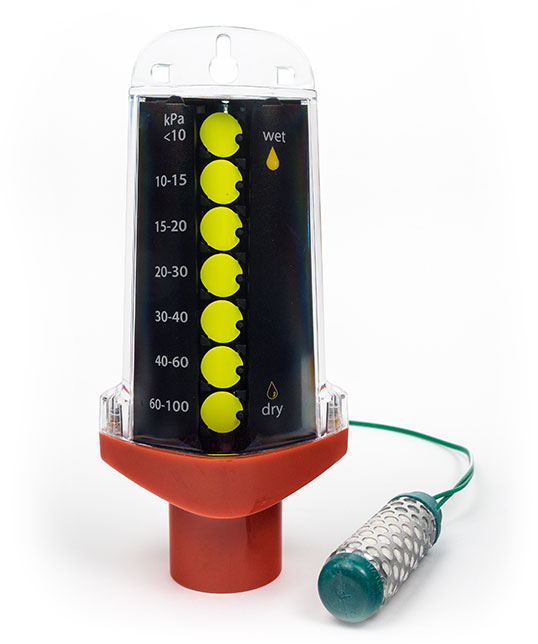
See when to water.
Simply.
The GDot shows you how much water is available to your crop.
It's designed to make irrigating simple. Just water when the number of yellow dots reaches the range for your crop. Then fine tune for your soils, season, crop stage.
No logins to complicated software. No ongoing maintenance. No annual fees. Just dots.
Check the GDot when you drive past, or from your kitchen window, or fly your drone down to take a look. The GDot makes irrigating easy. And efficient.
Find Your Crop
Get crop-specific details on using the GDot to schedule irrigation
{{ crop.name }}




How to Maintain
The GDot is simple to install and maintain.
Your GDot will work straight out of the box - just install the sensor 10-20 cm from a dripper, or within the wetting zone of your irrigation system, then plug the sensor into the display. It's powered by 2 'AA' batteries (supplied). After a few years, when these need to be replaced, click here to see how.
Each GDot includes a single Watermark sensor (we call them gypsum blocks). These sensors are used for irrigation scheduling around the world in almost all soil types. If you have very sandy soil or heavy clays, click here to see if the GDot sensor will still be suitable for you. If you have typical soil conditions for agriculture, you can rely on them to give accurate readings and to be maintenance free for many years.
Your soil type, irrigation frequency and local rainfall all influence how long a Watermark sensor will last, but you should expect between 2 and 5 years.
Click here to see how you'll know when it's time to replace the sensor, and how that's done.
Buy Now
Get your hands on the easiest irrigation scheduling tool around.
What's in the box
1 x GDot Soil Moisture Tension Display
1 x Gypsum Block soil moisture sensor with 2 metres of cable
2 x 'AA' batteries, pre-installed
Screws and cable ties to mount the GDot
Sand/bentonite mix for installation

{{ currency.symbol }}{{ defaultPrice }}
{{ currency.name }} per unit excluding GST
Not using {{ currency.name }}? Click here to change currency
Buy Online
Find a Dealer
Contact
Current prices will be shown in {{ currency.name }}.
ContinueWatermark sensors are designed for use in typical soil conditions, from sandy loam to heavy clay. Exceptionally coarse or loose soils like sand or potting mixes do not present good conditions for Watermark sensors, potentially leading to very slow sensor response.
Select one of the options below to find out more about these specific soils or use cases:
In very coarse sands, the Watermark sensor can respond too slowly to drying soils so the GDot will show 7 dots for too long.
Why is this?
Each Watermark sensor has a small amount of gypsum embedded inside that reacts to changes in soil moisture. When moisture in the surrounding soil is high, water moves into the sensor and increases the reactivity of the gypsum, which is measured and converted to a level of soil moisture tension. Moisture also moves out of the sensor into the surrounding soil as the soils dry, which reduced the reactivity of the gypsum in the sensor.
Very coarse sands have large interstitial pore spaces, which don't allow for good transfer of water between the sensor and the surrounding soil. That means the sensor reads wetter than the surrounding soil as things are drying out. And that really isn’t very good!
In these circumstances, installing the sensor into a slurry of silica flour and water, or a little kaolinite and water, can improve contact with the soil and its responsiveness to drying trends. However, we recommend you consult your agronomist and watch how the GDot responds over a few weeks before you change how you are irrigating.
The same problem exists for non-wetting soils, which develop an oily surface because a fungus produces fulvic acid that coats the particles. Once this dries out, the soil repels water, so any moisture already inside the sensor stays there. This means the GDot shows that the soil is wet, whereas it’s only the sensor that is. The soil surrounding might well be dry. So if you know that you have non-wetting soils, then adding organic matter, and clays can remediate this to an extent, and have a chat to your agronomist, or get in contact with us at gdot@gdot.com.au before installing the GDot.
The Watermark sensor reads soil moisture tension well in heavy clay, however most crops grown in these soils are left to draw moisture from the soil at much higher soil moisture tensions (>700 kPa for some red grapes, >1500 kPa for wheat). So it’s worth highlighting the range of the GDot is between <10 kPa and 100 kPa. Perfect for vegetables, not ideal for crops with a bit more tolerance to dry conditions. Chat with your agronomist, or have a look at our crop table as a guide if you are not sure.
Each Watermark uses a small amount of gypsum embedded inside the sensor to react to changes in soil moisture. When moisture in the surrounding soil is high, water moves into the sensor and increases the reactivity of the gypsum, which is measured and converted to a level of soil moisture tension. Moisture also moves out of the sensor into the surrounding soil as the soils dry, which reduced the reactivity of the gypsum in the sensor.
For crops in sandy soils that are irrigated frequently (once or more per day), the response time of the GDot is potentially too slow to react to the drying soils. In sandy soils, the different poor spacing between the soil and the sensor leads to a slower drying response of the sensor when compared with the surrounding soils in the wettest range. This means that seven yellow dots can be displayed for over 24 hours after an irrigation event, despite the actual soil moisture being drier than what this suggests so the GDot is potentially not suitable when scheduling high-frequency irrigation in sandy soil.

